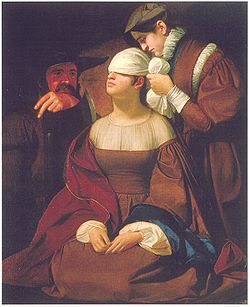
Lady Jane Grey Preparing for Execution (painting)
Encyclopedia

Oil painting
Oil painting is the process of painting with pigments that are bound with a medium of drying oil—especially in early modern Europe, linseed oil. Often an oil such as linseed was boiled with a resin such as pine resin or even frankincense; these were called 'varnishes' and were prized for their body...
by the American artist George Whiting Flagg
George Whiting Flagg
George Whiting Flagg from New Haven, Connecticut, was an American painter of historical scenes and genre pictures...
which established his early fame. This fame was however to dwindle as a consequence of a decline in the role of historical painting in American art. It was originally meant to represent Mary, Queen of Scots, but Flagg decided to change it to Lady Jane Grey
Lady Jane Grey
Lady Jane Grey , also known as The Nine Days' Queen, was an English noblewoman who was de facto monarch of England from 10 July until 19 July 1553 and was subsequently executed...
in mid-work. In a letter to Lumen Reed on June 16, 1834, he said:
- "I have changed the name of my picture to Lady Jane Gray [sic]. I find that Mary was too old at the time of her exicution [sic] to make an interesting picture."
A heroic Lady Jane, Protestant martyr, clad in royal purple, head held high, is blindfolded for execution by sympathetic executioners. Notably absent are any crucifixes, beads, medallions or other signs of "popery" distinguishing the religious life of Catholics from that of Protestants.
The painting appears to show her being blindfolded indoors, in reality she was executed outdoors and would probably only have been blindfolded after she was led onto the scaffold.

